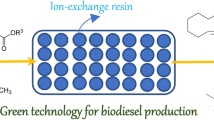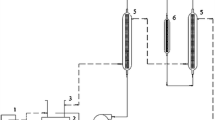Abstract
A novel production process of biodiesel fuel was developed using an expanded-bed reactor packed with an anion-exchange resin having catalytic and adsorption abilities. Waste cooking oil was used as a cheaper feedstock, and methanol was added at the stoichiometric molar ratio of 3:1. The main constituent of the feedstock, triglyceride was completely converted to the biodiesel by the resin’s catalytic ability. The impurities of the feedstock, free fatty acid, water, and dark brown pigment were removed from the product by the adsorption on the resin. In addition, the by-product glycerin was also removed from the product by the adsorption on the resin. The product eluted from the reactor was directly used for the standard tests of the biodiesel properties. The eluted product almost met the biodiesel quality standards (EN14214 in Europe and ASTM D6751 in North America). Thus, the proposed system permitted the simple production of biodiesel from the waste cooking oil without the upstream processing to remove the impurities (free fatty acid and water) and the downstream processing to remove the catalyst and by-products (glycerin and soap).





Similar content being viewed by others
References
Ma F, Hanna MA (1999) Biodiesel production: a review. Bioresour Technol 70:1–15
Fukuda H, Kondo A, Noda H (2001) Biodiesel fuel production by transesterification of oils. J Biosci Bioeng 92:405–416
Meher LC, Vidya Sagar D, Naik SN (2006) Technical aspects of biodiesel production by transesterification—a review. Renew Sust Energ Rev 10:248–268
Demirbas A (2007) Progress and recent trends in biofules. Prog Energy Combust Sci 33:1–18
Marchetti JM, Miguel VU, Errazu AF (2007) Possible methods for biodiesel production. Renew Sust Energ Rev 11:1300–1311
Sharma YC, Singh B, Upadhyay SN (2008) Advancements in development and charactericasion of biodiesel: a review. Fuel 87:2355–2373
Zhang Y, Dube MA, McLean DD, Kates M (2003) Biodiesel production from waste cooking oil: 1. Process design and technological assesment. Bioresour Technol 89:1–16
Zhang Y, Dube MA, McLean DD, Kates M (2003) Biodiesel production from waste cooking oil: 2. Economic assessment and sensitivity analysis. Bioresour Technol 90:229–240
Hasheminejad M, Tabatabaei M, Mansourpanah Y, Khatami far M, Javani A (2011) Upstream and downstream stratefies to economize biodiesel production. Bioresour Technol 102:461–468
Leung DYC, Wu X, Leung MKH (2010) A review on biodiesel production using catalyzed transesterification. Appl Energy 87:1083–1095
Shibasaki-Kitakawa N, Honda H, Kuribayashi H, Toda T, Fukumura T, Yonemoto T (2007) Biodiesel production using anionic ion-exchange resin as heterogeneous catalyst. Bioresour Technol 98:416–421
Shibasaki-Kitakawa N, Tsuji T, Chida K, Kubo M, Yonemoto T (2010) Simple continuous production process of biodiesel fuel from oil with high content of free fatty acid using ion-exchange resin catalysts. Energy Fuels 24:3634–3638
Tsuji T, Kubo M, Shibasaki-Kitakawa N, Yonemoto T (2009) Is excess methanol addition required to drive transesterification of triglyeceride toward complete conversion? Energy Fuels 23:6163–6167
Komers K, Stloukal R, Machek J, Skopal F, Komersova A (1998) Biodiesel fuel from rapeseed oil, methanol and KOH. Analytical methods in research and production. Fett-Lipid 100:507–512
Holcapek M, Jandera P, Fischer J, Prokes B (1999) Analytical monitoring of the production of biodiesel by high-performance liquid chomatography with various detection methods. J Chomatogr A 858:13–31
Komers K, Stloukal R, Machek J, Skopal F (2001) Biodiesel from rapeseed oil, methanol and KOH 3. Analysis of composition of actual reaction mixture. Eur J Lipid Sci Technol 103:363–371
Berrios M, Skelton RL (2008) Comparison of purification methods for biodiesel. Chem Eng J 144:459–465
Author information
Authors and Affiliations
Corresponding author
Rights and permissions
About this article
Cite this article
Shibasaki-Kitakawa, N., Tsuji, T., Kubo, M. et al. Biodiesel Production from Waste Cooking Oil Using Anion-Exchange Resin as Both Catalyst and Adsorbent. Bioenerg. Res. 4, 287–293 (2011). https://doi.org/10.1007/s12155-011-9148-0
Published:
Issue Date:
DOI: https://doi.org/10.1007/s12155-011-9148-0




